When you want color and motion in your tank, odds are at some point you will consider one or another species of wrasse.
In this article, we touch on the basics of including wrasses in a tank as well as list our favorite reef-safe species to consider.
What is a “Reef-Safe” Wrasse?
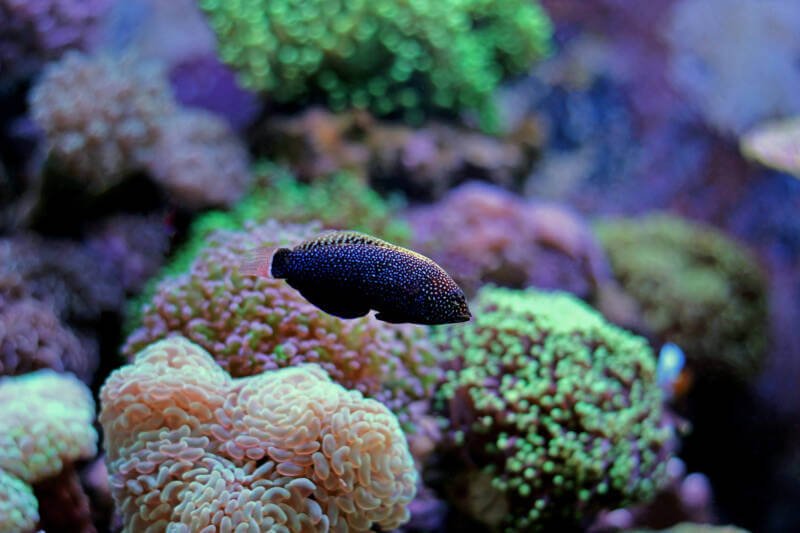
Reef-safe means that the species can live in a reef tank with little to no chance that they will damage the inhabitants.
There are varying levels of “safety.” Some species will not pick at the corals nor bother any invertebrates in the tank.
Others may not bother corals but could snack on invertebrates if they are not adequately fed. Still, other wrasse species should not be considered for a reef tank.
Fortunately, there are numerous reef-safe species from which to choose.
Set Up the Ideal Tank
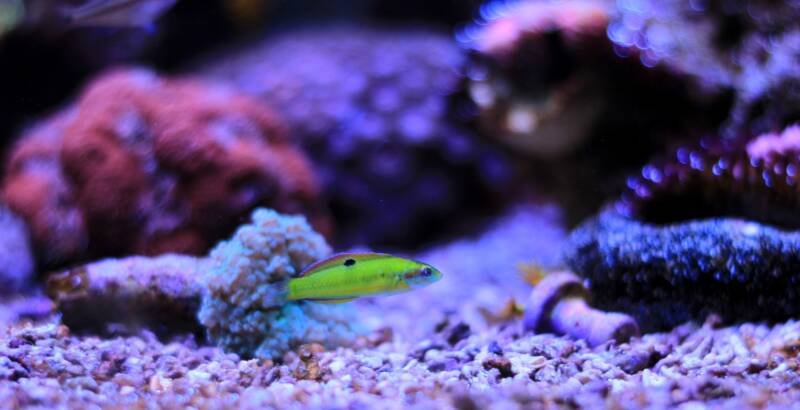
Step one is to set up the best habitat possible for all species you plan to include. When adding a wrasse to the mix, consider the following:
1 – Line your tank bottom with a thick layer of sand
Most wrasse species prefer to burrow into the sand to hide or to sleep.
Around two inches (5 cm) of soft sand should be sufficient.
Newly introduced wrasses may dive into the sand and remain there for days on end. Do not be alarmed.
They should eventually emerge for food when they are comfortable.
With a few exceptions, your wrasse will sleep in the sand, wrapped in a protective mucus cocoon.
2 – Do not skimp on the hiding spaces
Wrasses that do not sleep in the sand will rest in caves or rockwork.
Both cave and sand-sleeping wrasses need a safe place to duck into to whenever they are stressed.
Make sure there are sufficient places for all and space them out within the tank.
3 – Cover the tank with a tight-fitting lid!
All wrasse species are talented jumpers, so an open tank is completely out.
They can also manage to get through small openings, so make sure to cover these and secure the lid.
4 – Keep the water conditions stable
Some species of wrasse are extraordinarily sensitive to shifts in water conditions.
Know the specific needs of the species you are adding to your home aquarium.
Reputable breeders will give you detailed instructions on how to acclimate your wrasse as well as their care and feeding needs.
5 – Feed Them Often and Well
Wrasses are highly active fish with short digestive tracts. You will need to feed these fish multiple times each day.
One or two daily feedings will not suffice, and some species can eat up to five times a day.
When they are in a tank with other species that are enthusiastic eaters, the frequent feeding schedule for the wrasses can lead to overfeeding your other fish.
6 – Always introduce your wrasse to a well-established tank
Ensure there is plenty of live rock as well as hearty copepod and zooplankton populations to support the wrasses’ constant snacking.
7 – Remember that wrasses are carnivores
They need a regular diet of meaty foods and will snack on any small, live prey found in the aquarium.
You can train some species to accept flake and pellet foods, but even so, these should only be part of your wrasse’s diet.
The rest should include fresh or frozen shrimp, worms, or mysis.
8 – Select Peaceful Tank Mates
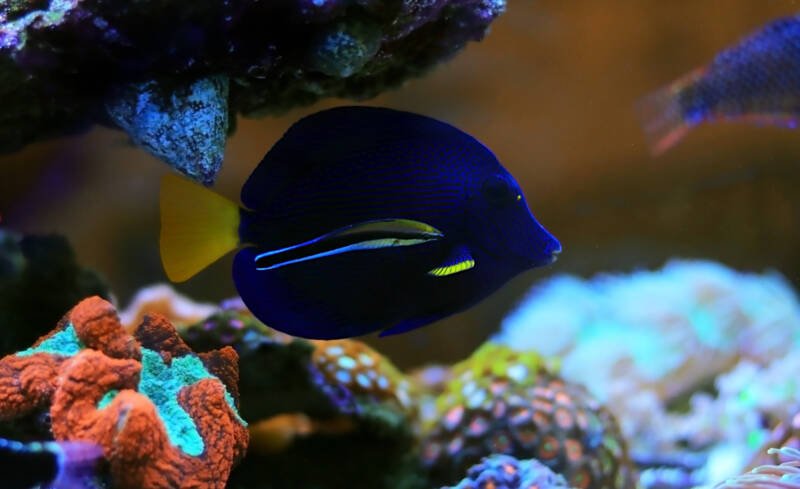
Some wrasses are semi-aggressive, while others are easily stressed.
Selecting similarly sized, peaceful species will help create the optimum environment for your wrasse.
9 – Quarantine the fish
Consider quarantine for your fish and use an acclimation box to introduce your wrasse to the main tank.
This can reduce the chance of bringing parasites into your tank. It can also reduce aggression once the wrasse is released.
Reef-Safe Wrasse Species
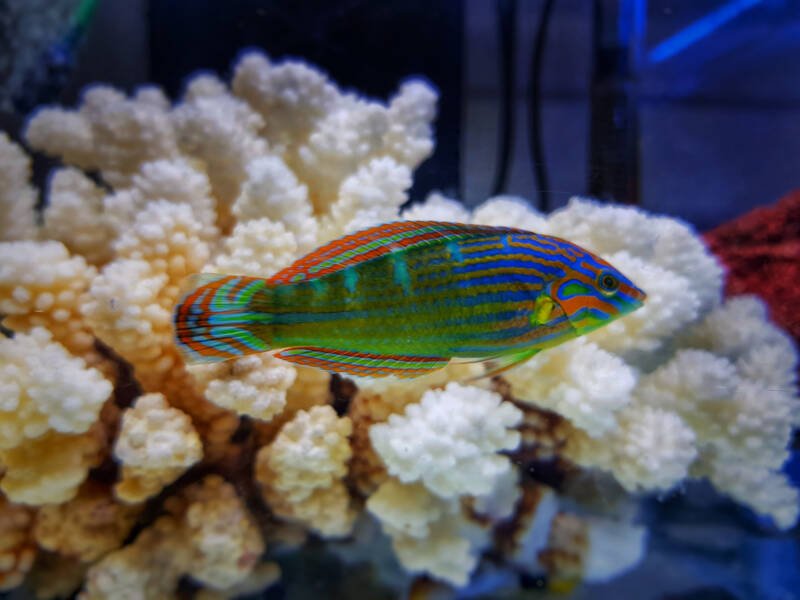
It was tough to narrow down our list, but the following are our top wrasse species for a reef tank.
1. Six-Line Wrasse (Pseudocheilinus hexataenia)
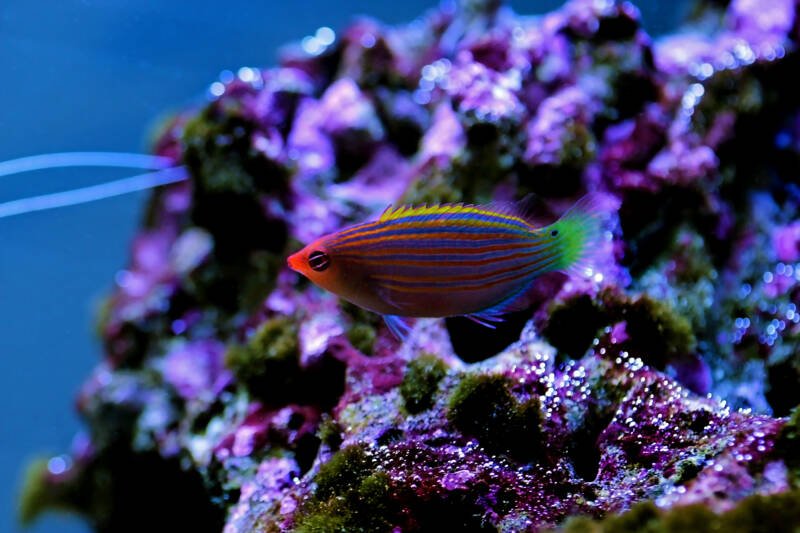
Minimum Tank Size: 30 gallons
Six-line wrasses are brightly colored fish from the Indo-Pacific region.
Their eye-catching, vivid orange-red stripes run horizontally from their head to the base of their tail.
These fish reach three inches (7.6 cm) in length and inhabit the middle to bottom layers of the water column.
This species can be aggressive toward other fish in the tank, especially more peaceful wrasse species and smaller invertebrates.
Add them to the tank last to allow the other fish to establish territories first. To further limit aggression, keep only a single six-line wrasse per tank.
2. Pink-Streaked Wrasse (Pseudocheilinops ataenia)
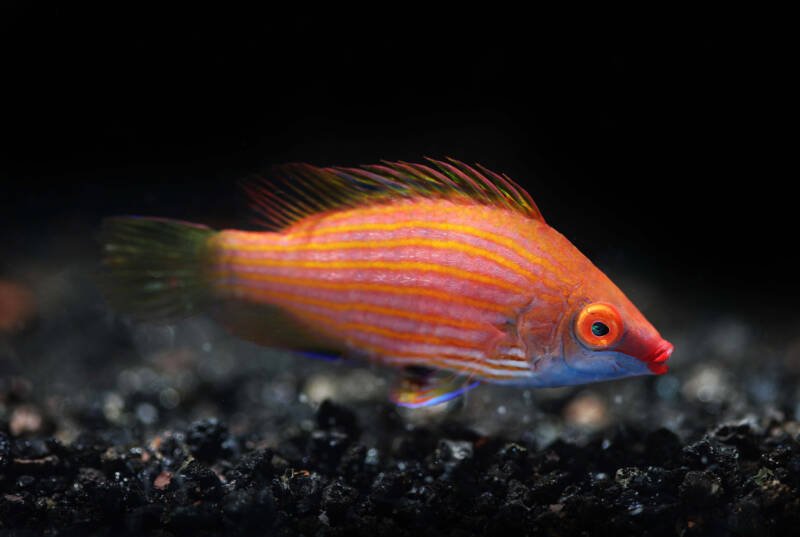
Minimum Tank Size: 15 gallons
This small Indonesian species brings pleasant pink, blue, and yellow colors to a home aquarium.
You can easily spot their dazzling red eyes among green plants and dark corals.
At a maximum length of 2.5 inches (6.4 cm), the aquarium size needed for this fish is reasonable.
They are easy to feed, as well, taking both pellet and frozen foods.
More aggressive wrasse species may harass the pink-streaked wrasse, which has a peaceful personality that generally flies under the radar of other fish in the tank.
With plenty of hiding spaces available, the pink-streaked wrasse will eventually become comfortable and quite active.
3. Mystery Wrasse (Pseudocheilinus ocellatus)
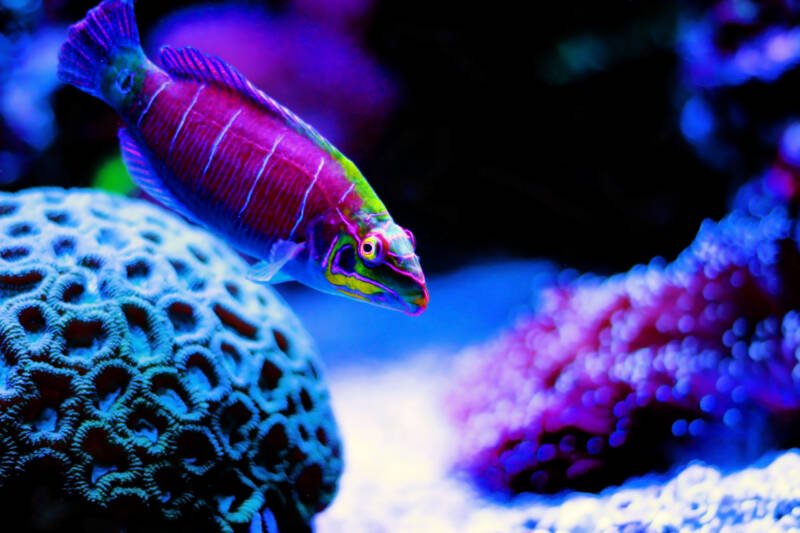
Minimum Tank Size: 55 gallons
Hailing from the Marshall Islands, the mystery wrasse is a lovely mix of colors with thin, white, vertical stripes and a uniquely patterned face.
This fish spends its time close to rockwork that provides a safe place to duck into while they scavenge for food.
As a result, mystery wrasses can be territorial when other fish invade their space.
Mystery wrasses reach up to 4.5 inches (11.4 cm) in length and are decent community tank inhabitants if they establish a territory.
Be aware that these fish have a higher purchase price than others on this list, so make sure the tank is suitable and follow all quarantine and acclimation guidelines.
4. Bluestreak Cleaner Wrasse (Labroides dimidiatus)
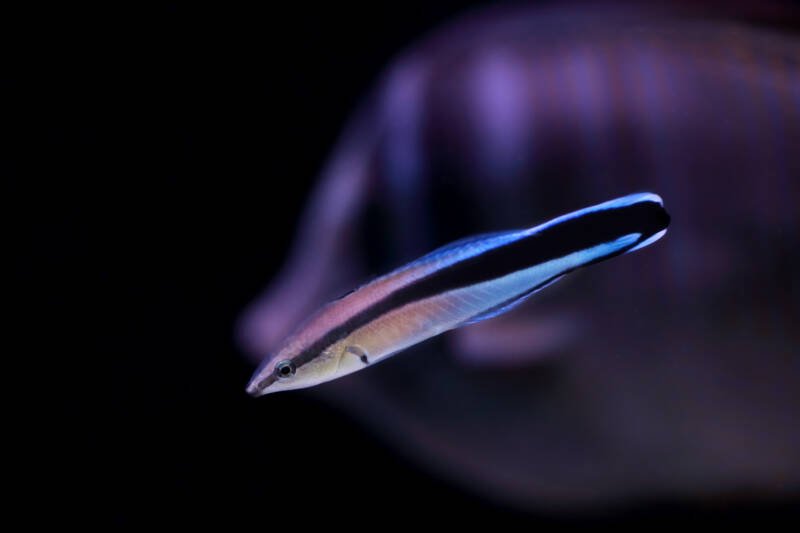
Minimum Tank Size: 90 gallons
The bluestreak cleaner wrasse has the unique habit of cleaning parasites and dead skin off other fish species.
This special relationship benefits all members of your community tank.
The other fish will learn to recognize the wrasse’s blue and black color and special movements. They will then come to the wrasse’s “cleaning station.”
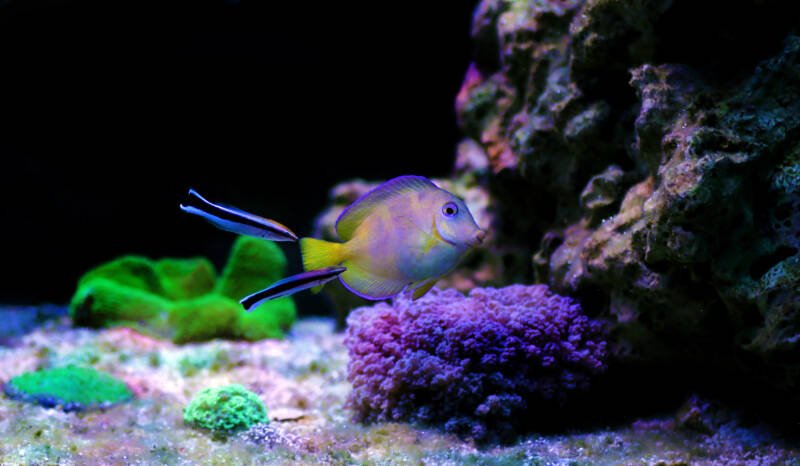
Bluestreaks are a peaceful species if housed with fish of dissimilar color, size, and shape.
They can live singly, in pairs, or small groups. The tank size may seem large for a fish reaching only 5.5 inches (14 cm) in length; however, this active species needs plenty of swimming room.
5. Leopard Wrasse (Macropharyngodon meleagris)
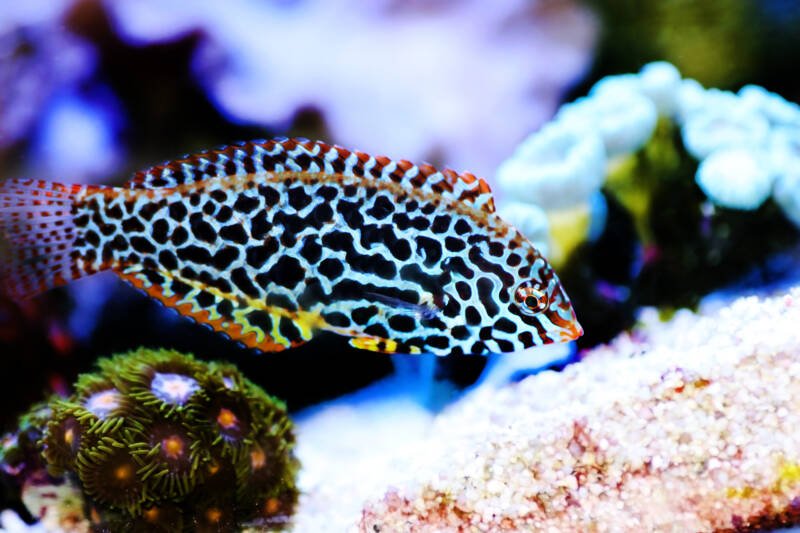
Minimum Tank Size: 100 gallons
The six-inch-long (15 cm) leopard wrasse sports a spotted color pattern resembling its land-based namesake.
There is also a black variation with a white to black color gradient.
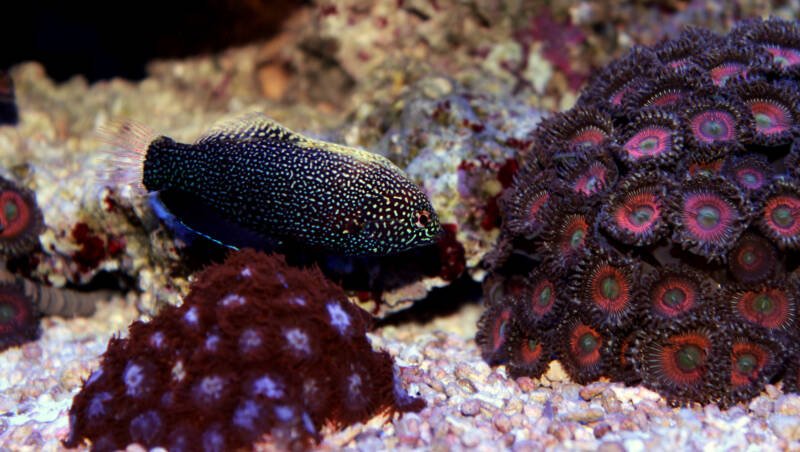
Despite its fierce name, the leopard wrasse is a peaceful fish that will not harass larger invertebrates but will clean pests, copepods, and zooplankton from the rocks in the tank.
These fish need a peaceful environment, a quiet location for their tank, and highly stable water parameters.
They will burrow into the substrate to hide or rest and need to eat five times a day.
Choose tank mates carefully as this species is prone to sickness due to stressors in its environment.
6. Exquisite Fairy Wrasse (Cirrhilabrus exquisitus)
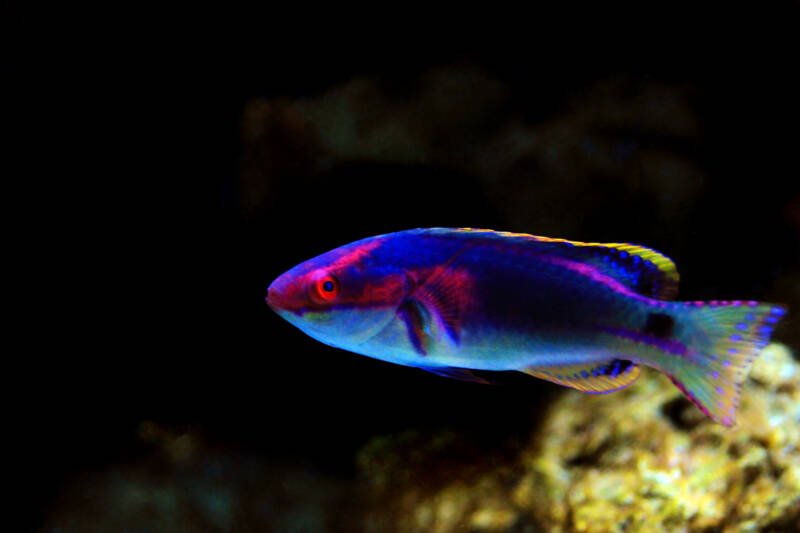
Minimum Tank Size: 90 gallons
The exquisite fairy wrasse is a red and blue-colored fish with an expansive natural range in the Pacific Ocean’s offshore reefs.
It loves a strong current and the fish often live in schools of varying size made up of predominantly females with one or two dominant males.
This species is not only peaceful toward other inhabitants in a community tank, but it also has little interest in nibbling corals or invertebrates.
At a length of only five inches (12.7 cm) fully grown, it is a manageable size for most aquarists.
This fish will need shaded areas in the tank along with the “typical” wrasse tank needs.
7. Melanurus Wrasse (Halichoeres melanurus)
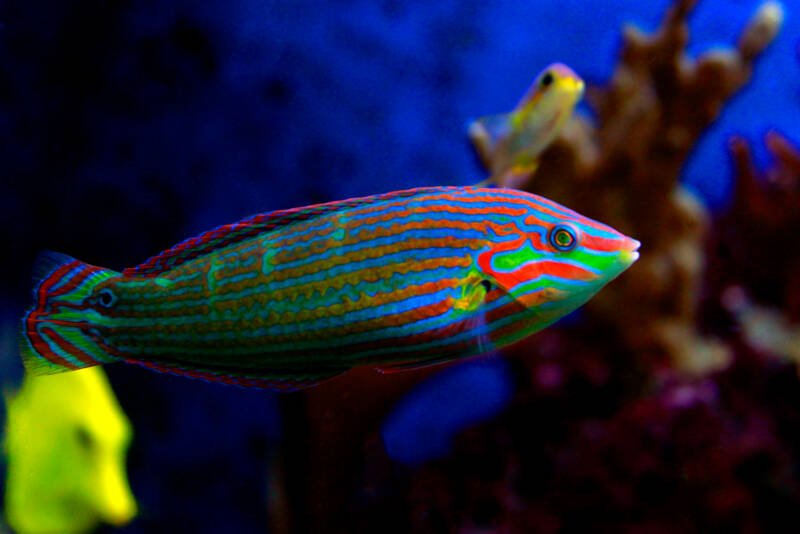
Minimum Tank Size: 100 gallons
The ultimate beginner wrasse, the melanurus is one of the easiest to care for and most beautiful you will find, with mesmerizing swirls and stripes of red, blue, and green.
This five-inch (12.7 cm) fish from deeper Western Pacific reefs needs a large tank that is taller than it is wide.
The melanurus is an easy-to-feed carnivore that will readily take a wide range of meaty foods.
Ensuring these fish have a variety of nutrients will bring out their best coloration.
Take care, however, when introducing them to a tank with invertebrates. This wrasse is known to snack on them.
Melanurus are enthusiastic eaters that can outcompete slower tank mates for food.
8. Carpenter’s Flasher Wrasse (Paracheilinus carpenteri)
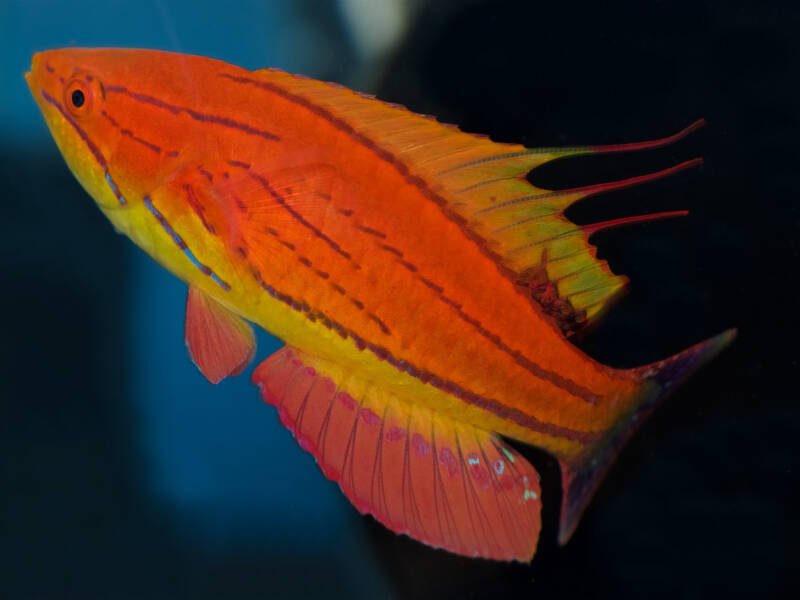
Minimum Tank Size: 55 gallons
With a pop of bright red and an elongated dorsal fin shape, the carpenter’s flasher wrasse is sure to spark conversation.
This peaceful species from the waters of Indonesia and Sumatra is somewhat smaller than other species on this list, maxing out at a length of three inches (7.6 cm).
Keep this fish in a group to promote the best coloration in the males.
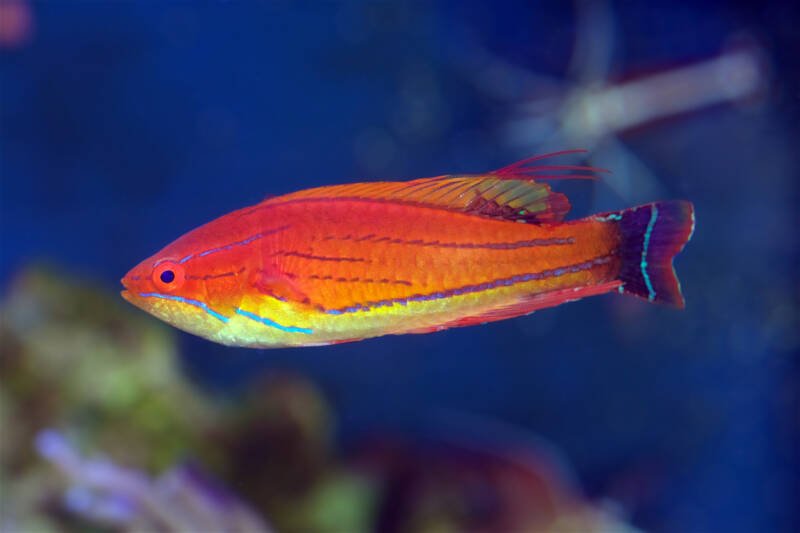
Introduce the females to the aquarium first; otherwise, other species may harass them. This is especially true if the community tank contains other species of wrasse.
This specimen is a fast eater, so make sure all fish get adequate nutrition.
9. Blue Star Leopard Wrasse (Macropharyngodon bipartitus)
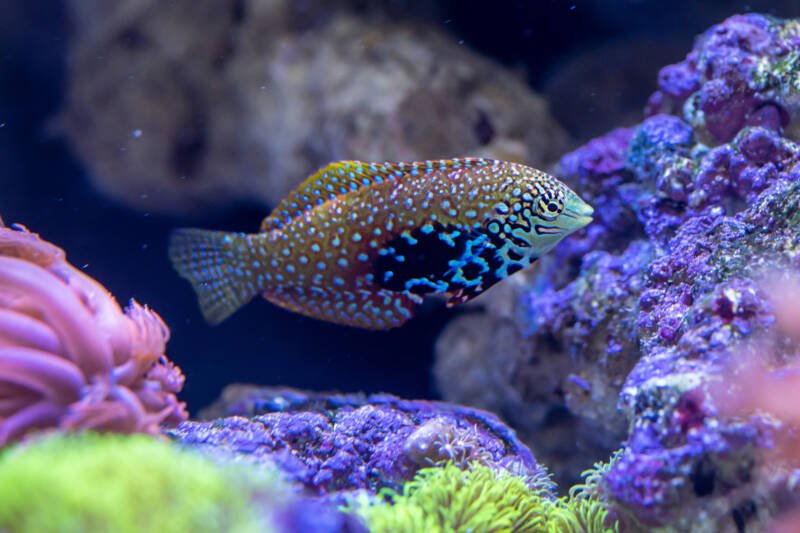
Minimum Tank Size: 50 gallons
The blue star leopard wrasse is a dimorphic species with both sexes showing lovely blue, black, and red coloration that will easily make them the center of attention in the tank.
They hail from lagoons and reefs in the western Indian Ocean and reach an adult length of five inches (12.7 cm).
These carnivores enjoy eating snails and protozoa that they find on living rock.
In the wild, females tend to shoal together within the range of a mature male.
These peaceful fish can inhabit a community tank singly, as a mated pair, or as a harem of females with a single male.
10. McCosker’s Flasher Wrasse (Paracheilinus mccoskeri)
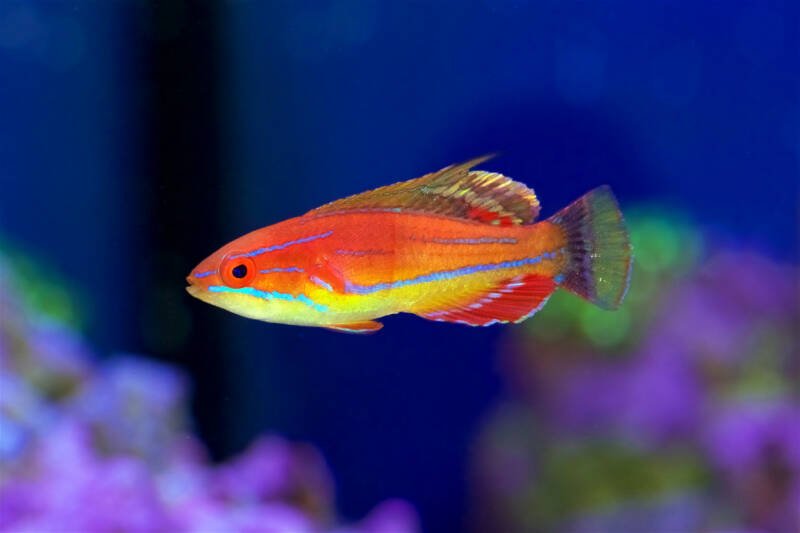
Minimum Tank Size: 30 gallons
The McCosker’s flasher wrasse is closely related to the carpenter’s flasher. A quick look at their fins will show the similarities.
The McCosker’s has spectacularly colored, elongated dorsal and anal fins and a bright orange body.
This hardy, three-inch-long (7.6 cm) fish is a peaceful Indo-Pacific native.
As with the carpenter’s, add the females first if keeping them in a group.
Always place these fish with other gentle-tempered species as they can be bullied by more aggressive types.
Limit the number of males in the tank or keep a single male with a group of females to see their best coloration.
11. Bluehead Fairy Wrasse (Cirrhilabrus cyanopleura)
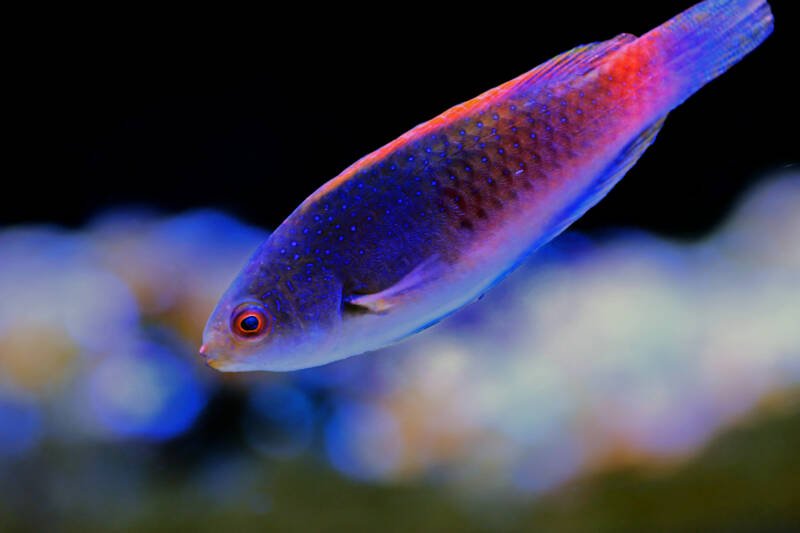
Minimum Tank Size: 90 gallons
The bluehead fairy wrasse has a pink-purple body with splashes of blue around the head and base of the fins.
They reach five inches (13 cm) fully grown and are amazing hunters that will scour the tank for copepods, worms, and parasites.
While they are safe around larger invertebrates, smaller ones may be at risk.
Place your bluehead fairy wrasse with similarly sized species that can hold their own against mild aggression; otherwise, the bluehead may push around any smaller or peaceful fish.
Avoid placing the bluehead with other wrasses and employ a large tank to help mitigate aggressive tendencies.
This fast swimmer does best in a long, rather than tall, tank.
12. Naoko’s Fairy Wrasse (Cirrhilabrus naokoae)
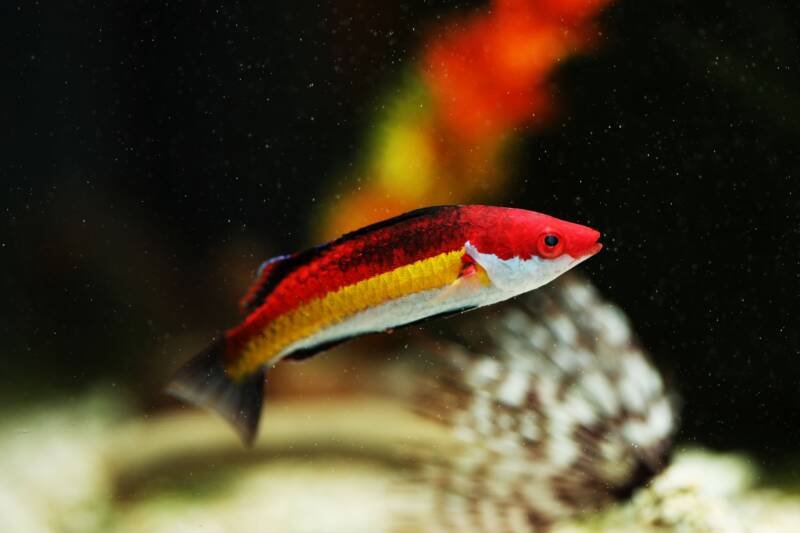
Minimum Tank Size: 50 gallons
Three bold bands of red, yellow, and white splash across the body of Naoko’s fairy wrasse.
This hardy and active species comes from the waters of the Indian Ocean and is suitable for a beginning-level aquarist.
Males tend to be more brightly colored than females and will display their fins when courting.
They are docile in a community tank and will leave corals and invertebrates in peace.
However, they can become territorial and chase away similar-looking species.
While they reach an adult length of only four inches (10 cm), they need a large tank to accommodate this territorial behavior.
13. Dusky Wrasse (Halichoeres marginatus)
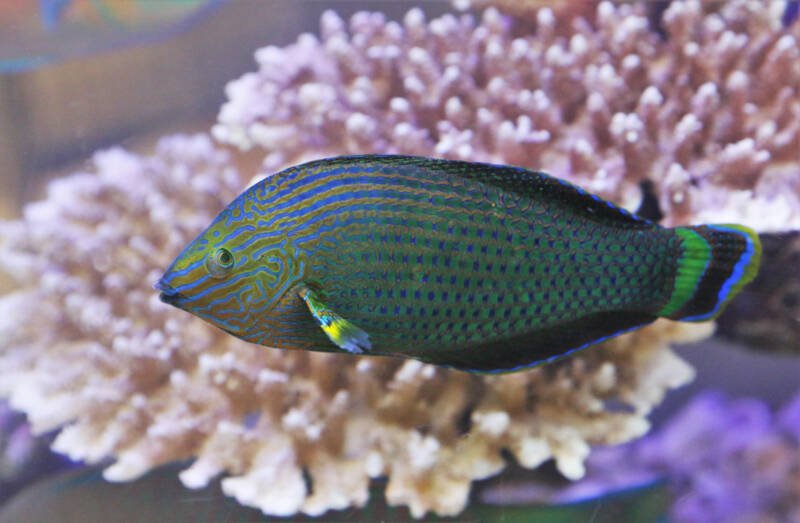
Minimum Tank Size: 75 gallons
The dusky wrasse goes through a color change from its juvenile to adult form but remains more subdued compared to most of the species on this list.
They are shy in nature and appear singly off the coasts of East Africa, Australia, Hawaii, and southern Japan.
Their darker color allows them to better blend into their environment.
They are fast swimmers that need adequate swimming space.
As specimens in the aquarium trade are often wild-caught, they can have difficulty acclimating to a captive diet.
Introduce them to well-established tanks with plenty of copepod and zooplankton growth and supplement their healthy appetites.
They may opportunistically feed on smaller invertebrates in the tank.
14. Yellow Banded Possum Wrasse (Wetmorella nigropinnata)
Minimum Tank Size: 15 gallons
The yellow-banded possum wrasse features a red-orange body, two bright yellow stripes on its head and tail, and multiple dark “false eye” spots.
This Indonesian species is easy to care for and stays small, reaching a maximum length of three inches (7.6 cm).
The yellow-banded possum wrasse is highly adaptable and eats a varied diet of commercial, live, and frozen foods.
They are busy fish that enjoy living in a group. Keep a single male with a group of females and introduce the females to the tank first.
As with other wrasse species, they can be territorial with similar-looking fish. If keeping a group of them, a single male with multiple females is best.
15. Flame Fairy Wrasse (Cirrhilabrus jordani)
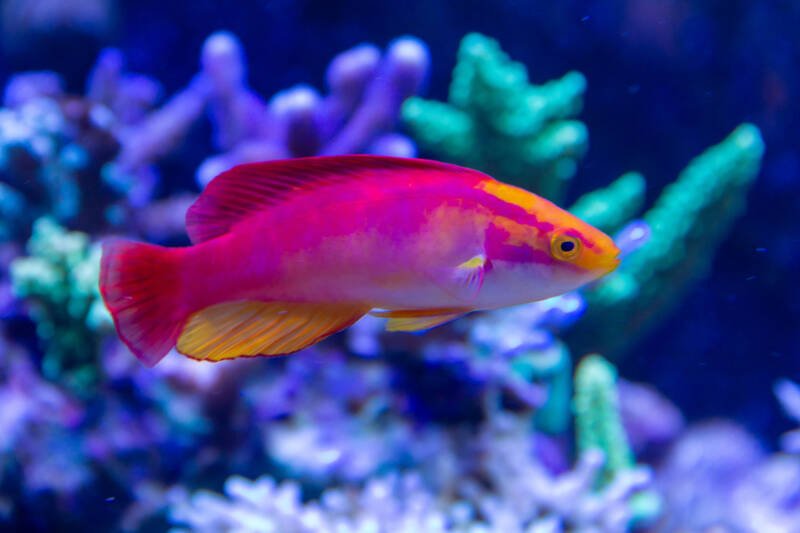
Minimum Tank Size: 80 gallons
The bright yellow body of the flame fairy wrasse is topped with bright red on the dorsal fin, tail fin, and top portion of the body.
Topping out at four inches (10 cm) in length as an adult, this fish can thrive in a moderately sized tank.
They can show aggression toward other wrasse species, so they are best kept in a tank with dissimilar fish.
While they generally leave invertebrates alone, those that are under a half an inch in size may be too tempting for the flame fairy to pass up.
Unlike other wrasse species, this one prefers to sleep in rock formations rather than burrowing into the sand, so make safe spaces available.
16. Golden Rhomboidalis Wrasse (Cirrhilabrus rhomboidalis)
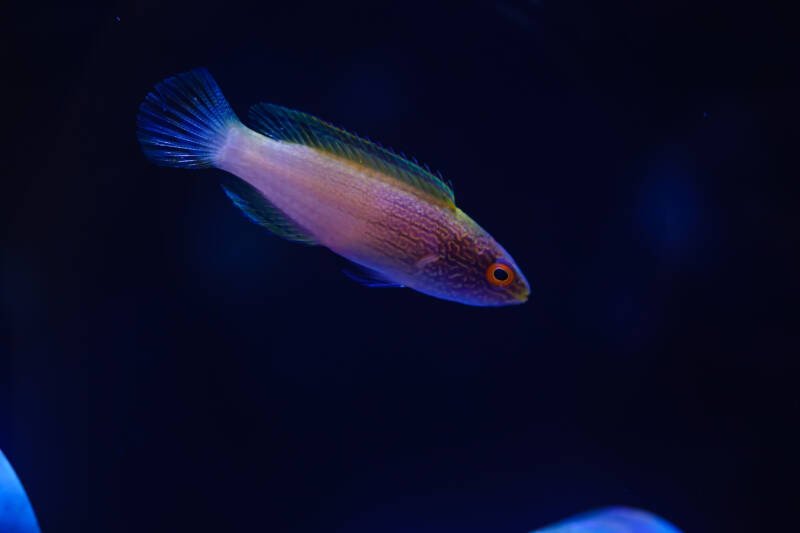
Minimum Tank Size: 90 gallons
The golden rhomboidalis wrasse has a limited natural habitat located in sandy, rocky areas near the Marshall Islands.
Its 4.5-inch (11 cm) body is a dappled gold color with splashes of purple at the base of the dorsal and anal fins.
Its semi-transparent tail is a subtle arrowhead shape, which gives it another common name, the diamond-tail wrasse.
This fish has an excellent temperament for both single-species or community reef aquariums.
It will not harass other species nor nibble on any invertebrates in the tank.
Make sure parts of the tank are shaded or away from bright light to keep the golden rhomboidalis comfortable.
17. Lubbock’s Fairy Wrasse (Cirrhilabrus lubbocki)
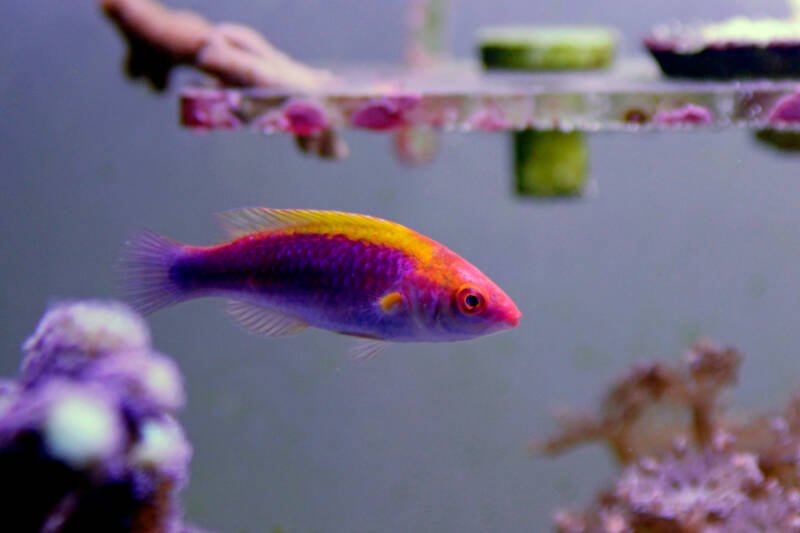
Minimum Tank Size: 55 gallons
The Lubbock’s fairy wrasse is a sturdy, smaller species that reaches only 3.5 inches (9 cm) as an adult.
Do not let that small size fool you. This fish can hold its own in a community tank and is considered a semi-aggressive species.
Avoid housing this fish with any flasher wrasse species as the two may be aggressive toward each other.
Include ample hiding places for your fairy wrasse to slip into as needed.
Be aware that your wrasse may view smaller saltwater shrimp species as food.
These fish will easily acclimate to eating flake, live, and frozen foods, making nutrition easy as long as they receive a well-rounded variety.
18. Scott’s Fairy Wrasse (Cirrhilabrus scottorum)
Minimum Tank Size: 90 gallons
Scott’s fairy wrasse comes in three color variations depending on its location of origin in Australia, Fiji, or the Cook Islands.
Whichever variation you select, this six-inch-long (15 cm) species is a lovely combination of blue, green, red, yellow, and black.
They can show aggression if they are kept in too small of a tank or in a group with more than one male.
Dominant males can also be aggressive toward fish introduced after them, so make sure they are added to the tank last.
Do not pair them with invertebrates that are under two inches in length and feed these fish frequently.
19. Pintail Fairy Wrasse (Cirrhilabrus isosceles)
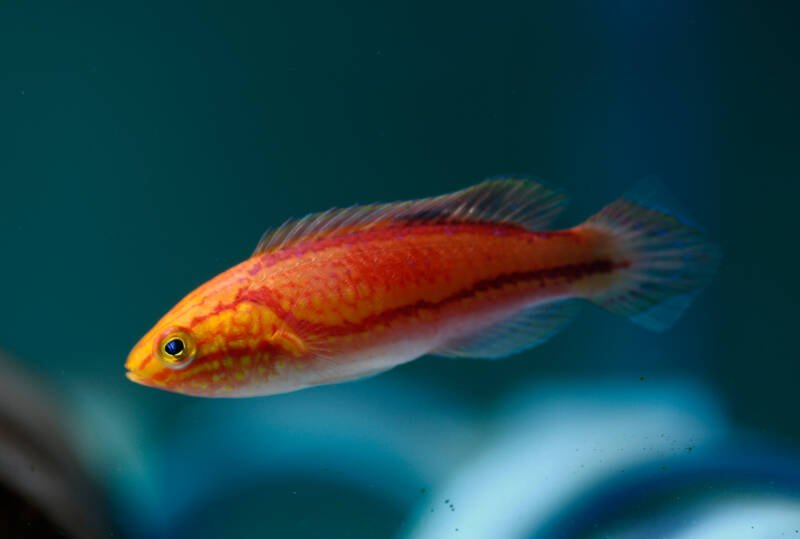
Minimum Tank Size: 90 gallons
The pintail fairy wrasse is a five-inch long (13 cm) beauty found widely from Japan to the Philippines.
What draws your attention instantly with this fish is the finnage.
Semi-transparent, yellow-tinted dorsal and anal fins grace the top and bottom of this fish.
The tail is fully transparent at the top and bottom tips, leaving a yellow, arrowhead shape visible.
To complement its color, the pintail is active, peaceful, and leaves invertebrates in your tank alone.
They can easily live as a single specimen or in a group, in a single-species tank or a community reef.
With these positive attributes, this fish is worth the higher cost.
20. Lineatus Fairy Wrasse (Cirrhilabrus lineatus)
Minimum Tank Size: 90 gallons
The lineatus fairy wrasse is an explosion of blue, orange, and yellow colors, with flashy fins and striking orange eyes.
This five-inch-long (13 cm) fish comes straight from the waters of the Coral Sea and Great Barrier Reef and is not often seen in the aquarium trade.
These fish are hardy, easy to care for, and excellent in both single-species and community aquariums.
They are peaceful, get along with their tank mates, and will not harm the corals or invertebrates in the tank.
If kept in a group, the dominant male will show vivid colors while the others will be more subdued.
21. Black-Backed Wrasse/China Wrasse (Anampses neoguinaicus)
Minimum Tank Size: 120 gallons
The black-backed wrasse is a larger species, measuring nine inches (23 cm) fully grown.
This Indo-Pacific native has a cream-colored body with varying shades of black on their top half reaching from just behind the tip of the head to the end of the dorsal fin. Rows of blue dots accent the darker areas.
Like the dusky wrasse, this fish is somewhat difficult to feed in a home aquarium.
Make sure your aquarium is well established with plenty of live rock.
Do not house the black-backed wrasse with ornamental invertebrates or crustaceans as it will feed on them.
This fish may be aggressive if kept in a group of its own kind.
22. Orange-Back Fairy Wrasse (Cirrhilabrus aurantidorsalis)
Minimum Tank Size: 90 gallons
The orange-back fairy wrasse is a gorgeous purple fish with, you guessed it, a bright orange back!
This native of Indonesian waters is both peaceful and active, bringing a pop of color and movement to a community tank.
Males develop a red hood as they mature, and their colors intensify when they are breeding.
These 4.5-inch (11 cm) fish are remarkably easy to care for and feed, even for the beginning aquarist.
In addition to its carnivorous diet, the orange-back will also accept marine flake and pellet foods.
As with most wrasse species, they like to burrow, so plan on a two-inch depth of sand on the tank bottom.
23. Neon Wrasse (Halichoeres garnoti)
Minimum Tank Size: 75 gallons
The neon or yellowhead wrasse is a bright yellow species found in shallow and deep reefs of the Caribbean and western Atlantic.
They reach a sizable seven inches (18 cm) when fully grown and go through a drastic color change from their juvenile to adult form.
This fish is not only comfortable when kept with a group of its own kind, but it can also live with other wrasse species as well as similarly sized, peaceful fish.
Just make sure the tank size and setup allow for this territorial fish to stake its claim.
Neon wrasses have a hefty appetite and may snack on smaller invertebrates or crustaceans.
24. Red-Fin Fairy Wrasse (Cirrhilabrus adornatus)
Minimum Tank Size: 50 gallons
The male red-fin fairy wrasse has a lovely orange-red body and prominent red dorsal, ventral, and anal fins.
The female has smaller fins and a yellow tint to the body. These fish do not grow large, reaching around three inches (7.6 cm) fully grown, so tank size is reasonable.
Keep this species as a single specimen or in a group with one male and multiple females.
Do not house them with other wrasse species and observe the male’s interactions with any fish introduced after them.
These fish are wild-caught and are enthusiastic feeders that can learn to accept prepared flake and pellet foods.
Closing Thoughts
Wrasses are without a doubt one of the most beautiful and active species you can add to your reef aquarium.
While they require attention to water conditions, feeding schedules, and the selection of any tank mates, we feel that wrasses bring so much to the look and feel of the tank that these efforts are well worthwhile.
We would love to hear from you!
Let us know if we missed one of your favorite reef-safe wrasse species!